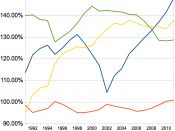Latin America has a large area of cultivable land, good climate and soil to suit every crop, surrounded with surplus water resources. The vast tract of fertile land gave birth to agriculture, cattle breeding, farming and growing variety of crops. Ever since the Incas civilisation, agriculture has been the main occupation for the people of Latin America. Both men and women work for hours under the hot sun to harvest the crops through out the year. Latin America's economy depends enormously on commodity export of agricultural products, making it very essential to the population of Latin America. However, agriculture faced many problems, one of them was mass migration.
In the following essay, I will explain various export models such as the 'Export-Import' growth model from the 1900's to the 1930's; the 'Import Substitution Industrialisation' (ISI) model of the 1930's to the 1980's and finally the new export model of the 1980's to present.
Whilst looking at these models I will explain how the various factors such as government, economy and external forces shaped Latin American agriculture.
The main occupation of Latin Americans was agriculture and land was communally owned but ever since Columbus introduced sugar in 1493, it initiated the export-import growth and dependence on commodity trade. The expansion of trade saw the introduction of a variety of crops and by-products that were in demand in the developed world. Over the years it influenced and began a non-merocratic society, which resulted in the shift of power and ownership of land to the elite that led to the oppression of the labourers in many Latin American countries.
In 1917 Latin America saw the first Agrarian reform in Mexico where many haciendas (large fields) were broken down and the land was once again shared communally. Although it benefited over...


